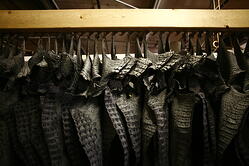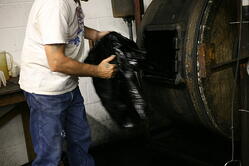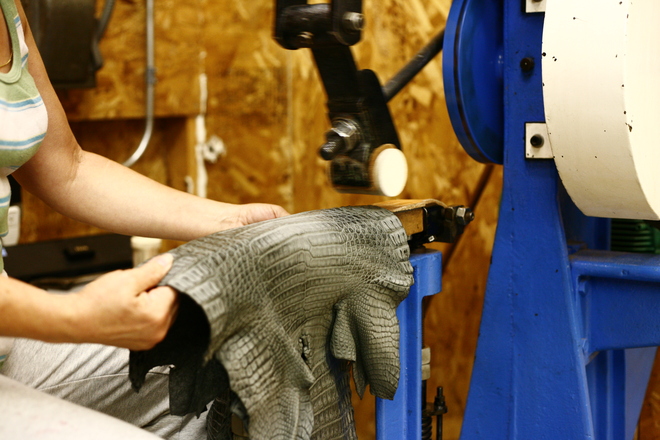
Hang Drying

Coloring
.jpg?width=250&height=166&name=finishing_(1).jpg)
Finishing
Some of you might be interested in learning a bit about the tanning process for our caiman skin. Tanning is essentially the transition of a raw skin into a leather, without which the skin would be susceptible to decomposition and bacteria. The process involves these steps:
- Dry salting as a preservative measure
- Beamhouse operations:
- Soaking to clean the skins
- Liming to descale them
- Deliming to raise the acidity
- Pickling to remove bone matter
- Chrome tanning to convert the material into inorganic material
- Shaving to degrease and thin out the leather
- Re-tanning to re-soften the leather for working
- Drying (either by hang-drying or by toggling)
- Dry cleaning
- Coloring
- Shaving to prepare the leather for the product
- Applying the finishing touches
The Beginning Steps
When we receive the skins from the suppliers, they're boardy and extremely susceptible to the elements. They arrive salted which removes the moisture from the skins and preserves them until we can work them. The first stage of the process is the beaming. First, we soak the caiman skin in water to clean them, remove the salt, and rehydrate the skin so that we can begin working them.
The Tanning Process
After that we move onto liming, which removes scales, nails, mucins, natural greases and fats. It also splits the fibers and makes the collagen in the skin workable. Next, we delime the skin to raise the acidity after the liming lowers it. The next phase is the pickling which is an acid bath that helps break down the bones and calcium in the caiman skin so that it is more pliable. After the pickling process comes the chrome bath which makes the skin durable and no longer susceptible to the elements. Once this is done, it is no longer an organic skin; it has become inorganic leather.
Finishing Touches
After this, we re-tan the caiman skin, this time using vegetable-based products. This is done so that the tougher skin that results from the initial tanning process is made supple again. From there, we dye the caiman skin, shave it down to the required thickness for the application, and then either hang-dry or "toggle" (which uses a special type of oven to evaporate the water) to remove the water and humidity. Lastly, we finish the caiman skin with seasons and protective coats so that it feels good, looks good, and is protected from the elements. From there, it goes onto the manufacturer where they turn it into the footwear, furniture, handbags, etc. that you're all familiar with.
That is the basic overview of our caiman skin tanning process, and we hope that it has been both informative and interesting to you. If you have any questions about anything in here, please feel free to comment below, and if you have any other inquiries, don't hesitate to contact us.



